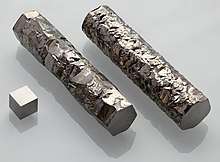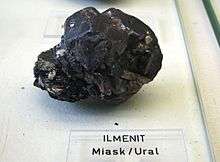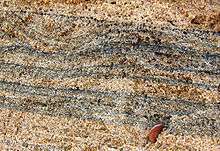Group 4 element
Group 4 is a group of elements in the periodic table. It contains the elements titanium (Ti), zirconium (Zr), hafnium (Hf) and rutherfordium (Rf). This group lies in the d-block of the periodic table. The group itself has not acquired a trivial name; it belongs to the broader grouping of the transition metals.
| Group 4 in the periodic table | |||||||||
|---|---|---|---|---|---|---|---|---|---|
| |||||||||
| ↓ Period | |||||||||
| 4 | 22 Transition metal | ||||||||
| 5 |  40 Transition metal | ||||||||
| 6 |  72 Transition metal | ||||||||
| 7 | Rutherfordium (Rf) 104 Transition metal | ||||||||
|
Legend primordial element
synthetic element
Black atomic number: solid | |||||||||
The three group 4 elements that occur naturally are titanium, zirconium and hafnium. The first three members of the group share similar properties; all three are hard refractory metals under standard conditions. However, the fourth element rutherfordium (Rf), has been synthesized in the laboratory; none of its isotopes have been found occurring in nature. All isotopes of rutherfordium are radioactive. So far, no experiments in a supercollider have been conducted to synthesize the next member of the group, either unpenthexium (Uph, element 156) or unpentoctium (Upo, element 158), and it is unlikely that they will be synthesized in the near future.
Characteristics
Chemistry
Like other groups, the members of this family show patterns in its electron configuration, especially the outermost shells resulting in trends in chemical behavior:
| Period | Z | Element | No. of electrons/shell |
|---|---|---|---|
| 4 | 22 | titanium | 2, 8, 10, 2 |
| 5 | 40 | zirconium | 2, 8, 18, 10, 2 |
| 6 | 72 | hafnium | 2, 8, 18, 32, 10, 2 |
| 7 | 104 | rutherfordium | 2, 8, 18, 32, 32, 10, 2 |
Most of the chemistry has been observed only for the first three members of the group. The chemistry of rutherfordium is not very established and therefore the rest of the section deals only with titanium, zirconium, and hafnium. All the elements of the group are reactive metals with a high melting point (1668 °C, 1855 °C, 2233 °C, 2100 °C?). The reactivity is not always obvious due to the rapid formation of a stable oxide layer, which prevents further reactions. The oxides TiO2, ZrO2 and HfO2 are white solids with high melting points and unreactive against most acids.[1]
As tetravalent transition metals, all three elements form various inorganic compounds, generally in the oxidation state of +4. For the first three metals, it has been shown that they are resistant to concentrated alkalis, but halogens react with them to form tetrahalides. At higher temperatures, all three metals react with oxygen, nitrogen, carbon, boron, sulfur, and silicon. Because of the lanthanide contraction of the elements in the fifth period, zirconium and hafnium have nearly identical ionic radii. The ionic radius of Zr4+ is 79 picometers and that of Hf4+ is 78 pm.[1][2]
This similarity results in nearly identical chemical behavior and in the formation of similar chemical compounds.[2] The chemistry of hafnium is so similar to that of zirconium that a separation on chemical reactions was not possible; only the physical properties of the compounds differ. The melting points and boiling points of the compounds and the solubility in solvents are the major differences in the chemistry of these twin elements.[1] Titanium is considerably different from the other two owing to the effects of the lanthanide contraction.
Physical
The table below is a summary of the key physical properties of the group 4 elements. The four question-marked values are extrapolated.[3]
| Name | Titanium | Zirconium | Hafnium | Rutherfordium |
|---|---|---|---|---|
| Melting point | 1941 K (1668 °C) | 2130 K (1857 °C) | 2506 K (2233 °C) | 2400 K (2100 °C)? |
| Boiling point | 3560 K (3287 °C) | 4682 K (4409 °C) | 4876 K (4603 °C) | 5800 K (5500 °C)? |
| Density | 4.507 g·cm−3 | 6.511 g·cm−3 | 13.31 g·cm−3 | 23.2 g·cm−3? |
| Appearance | silver metallic | silver white | silver gray | ? |
| Atomic radius | 140 pm | 155 pm | 155 pm | 150 pm? |
History

Titanium
British mineralogist William Gregor first identified titanium in ilmenite sand beside a stream in Cornwall, Great Britain in the year 1791.[4] After analyzing the sand, he determined the weakly magnetic sand to contain iron oxide and a metal oxide that he could not identify.[5] During that same year, mineralogist Franz Joseph Muller produced the same metal oxide and could not identify it. In 1795, chemist Martin Heinrich Klaproth independently rediscovered the metal oxide in rutile from the Hungarian village Boinik.[4] He identified the oxide containing a new element and named it for the Titans of Greek mythology.[6]
Zirconium
Martin Heinrich Klaproth discovered zirconium when analyzing the zircon containing mineral jargoon in 1789. He deduced that the mineral contained a new element and named it after the already known Zirkonerde (zirconia).[7] However, he failed to isolate the newly discovered zirconium. Cornish chemist Humphry Davy also attempted to isolate this new element in 1808 through electrolysis, but failed.[8] In 1824, Swedish chemist Jöns Jakob Berzelius isolated an impure form of zirconium, obtained by heating a mixture of potassium and potassium zirconium fluoride in an iron tube.[7]
Hafnium
Hafnium had been predicted by Dmitri Mendeleev in 1869 and Henry Moseley measured in 1914 the effective nuclear charge by X-ray spectroscopy to be 72, placing it between the already known elements lutetium and tantalum. Dirk Coster and Georg von Hevesy were the first to search for the new element in zirconium ores.[9] Hafnium was discovered by the two in 1923 in Copenhagen, Denmark, validating the original 1869 prediction of Mendeleev.[10] There has been some controversy surrounding the discovery of hafnium and the extent to which Coster and Hevesy were guided by Bohr's prediction that hafnium would be a transition metal rather than a rare earth element.[11] While titanium and zirconium, as relatively abundant elements, were discovered in the late 18th century, it took until 1923 for hafnium to be identified. This was only partly due to hafnium's relative scarcity. The chemical similarity between zirconium and hafnium made a separation difficult and, without knowing what to look for, hafnium was left undiscovered, although all samples of zirconium, and all of its compounds, used by chemists for over two centuries contained significant amounts of hafnium.[12]
Rutherfordium
Rutherfordium was reportedly first detected in 1966 at the Joint Institute of Nuclear Research at Dubna (then in the Soviet Union). Researchers there bombarded 242Pu with accelerated 22Ne ions and separated the reaction products by gradient thermochromatography after conversion to chlorides by interaction with ZrCl4.[13]
- 242
94Pu
+ 22
10Ne
→ 264−x
104Rf
→ 264−x
104Rf
Cl4
Production
The production of the metals itself is difficult due to their reactivity. The formation of oxides, nitrides and carbides must be avoided to yield workable metals; this is normally achieved by the Kroll process. The oxides (MO2) are reacted with coal and chlorine to form the chlorides (MCl4). The chlorides of the metals are then reacted with magnesium, yielding magnesium chloride and the metals.
Further purification is done by a chemical transport reaction developed by Anton Eduard van Arkel and Jan Hendrik de Boer. In a closed vessel, the metal reacts with iodine at temperatures above 500 °C forming metal(IV) iodide; at a tungsten filament of nearly 2000 °C the reverse reaction happens and the iodine and metal are set free. The metal forms a solid coating on the tungsten filament and the iodine can react with additional metal resulting in a steady turnover.[1][14]
- M + 2 I2 (low temp.) → MI4
- MI4 (high temp.) → M + 2 I2
Occurrence

If the abundance of elements in Earth's crust is compared for titanium, zirconium and hafnium, the abundance decreases with increase of atomic mass. Titanium is the seventh most abundant metal in Earth's crust and has an abundance of 6320 ppm, while zirconium has an abundance of 162 ppm and hafnium has only an abundance of 3 ppm.[15]
All three stable elements occur in heavy mineral sands ore deposits, which are placer deposits formed, most usually in beach environments, by concentration due to the specific gravity of the mineral grains of erosion material from mafic and ultramafic rock. The titanium minerals are mostly anatase and rutile, and zirconium occurs in the mineral zircon. Because of the chemical similarity, up to 5% of the zirconium in zircon is replaced by hafnium. The largest producers of the group 4 elements are Australia, South Africa and Canada.[16][17][18][19][20]
Applications
Titanium metal and its alloys have a wide range of applications, where the corrosion resistance, the heat stability and the low density (light weight) are of benefit. The foremost use of corrosion-resistant hafnium and zirconium has been in nuclear reactors. Zirconium has a very low and hafnium has a high thermal neutron-capture cross-section. Therefore, zirconium (mostly as zircaloy) is used as cladding of fuel rods in nuclear reactors,[21] while hafnium is used in control rods for nuclear reactors, because each hafnium atom can absorb multiple neutrons.[22][23]
Smaller amounts of hafnium[24] and zirconium are used in super alloys to improve the properties of those alloys.[25]
Biological occurrences
The group 4 elements are not known to be involved in the biological chemistry of any living systems.[26] They are hard refractory metals with low aqueous solubility and low availability to the biosphere. Titanium is one of the few first row d-block transition metals with no known biological role. Rutherfordium's radioactivity would make it toxic to living cells.
Precautions
Titanium is non-toxic even in large doses and does not play any natural role inside the human body.[26] Zirconium powder can cause irritation, but only contact with the eyes requires medical attention.[27] OSHA recommendations for zirconium are 5 mg/m3 time weighted average limit and a 10 mg/m3 short-term exposure limit.[28] Only limited data exists on the toxicology of hafnium.[29]
References
- Holleman, Arnold F.; Wiberg, Egon; Wiberg, Nils (1985). Lehrbuch der Anorganischen Chemie (in German) (91–100 ed.). Walter de Gruyter. pp. 1056–1057. ISBN 3-11-007511-3.
- "Los Alamos National Laboratory – Hafnium". Archived from the original on June 2, 2008. Retrieved 2008-09-10.
- Hoffman, Darleane C.; Lee, Diana M.; Pershina, Valeria (2006). "Transactinides and the future elements". In Morss; Edelstein, Norman M.; Fuger, Jean (eds.). The Chemistry of the Actinide and Transactinide Elements (3rd ed.). Dordrecht, The Netherlands: Springer Science+Business Media. ISBN 1-4020-3555-1.
- Emsley 2001, p. 452
- Barksdale 1968, p. 732
- Weeks, Mary Elvira (1932). "III. Some Eighteenth-Century Metals". Journal of Chemical Education. 9 (7): 1231–1243. Bibcode:1932JChEd...9.1231W. doi:10.1021/ed009p1231.
- Lide, David R., ed. (2007–2008). "Zirconium". CRC Handbook of Chemistry and Physics. 4. New York: CRC Press. p. 42. ISBN 978-0-8493-0488-0.
- Emsley, John (2001). Nature's Building Blocks. Oxford: Oxford University Press. pp. 506–510. ISBN 978-0-19-850341-5.
- Urbain, M. G. (1922). "Sur les séries L du lutécium et de l'ytterbium et sur l'identification d'un celtium avec l'élément de nombre atomique 72" [The L series from lutetium to ytterbium and the identification of element 72 celtium]. Comptes rendus (in French). 174: 1347–1349. Retrieved 2008-10-30.
- Coster, D.; Hevesy, G. (1923-01-20). "On the Missing Element of Atomic Number 72". Nature. 111 (2777): 79. Bibcode:1923Natur.111...79C. doi:10.1038/111079a0.
- Scerri, Eric (2007). The Periodic System, Its Story and Its Significance. New York: Oxford University Press. ISBN 978-0-19-530573-9.
- Barksdale, Jelks (1968). The Encyclopedia of the Chemical Elements. Skokie, Illinois: Reinhold Book Corporation. pp. 732–38 "Titanium". LCCCN 68-29938.
- Barber, R. C.; Greenwood, N. N.; Hrynkiewicz, A. Z.; Jeannin, Y. P.; Lefort, M.; Sakai, M.; Ulehla, I.; Wapstra, A. P.; et al. (1993). "Discovery of the transfermium elements. Part II: Introduction to discovery profiles. Part III: Discovery profiles of the transfermium elements". Pure and Applied Chemistry. 65 (8): 1757–1814. doi:10.1351/pac199365081757.
- van Arkel, A. E.; de Boer, J. H. (1925). "Darstellung von reinem Titanium-, Zirkonium-, Hafnium- und Thoriummetall (Production of pure titanium, zirconium, hafnium and Thorium metal)". Zeitschrift für Anorganische und Allgemeine Chemie (in German). 148 (1): 345–350. doi:10.1002/zaac.19251480133.
- "Abundance in Earth's Crust". WebElements.com. Archived from the original on 2008-05-23. Retrieved 2007-04-14.
- "Dubbo Zirconia Project Fact Sheet" (PDF). Alkane Resources Limited. June 2007. Archived from the original (PDF) on 2008-02-28. Retrieved 2008-09-10.
- "Zirconium and Hafnium" (PDF). Mineral Commodity Summaries. US Geological Survey: 192–193. January 2008. Retrieved 2008-02-24.
- Callaghan, R. (2008-02-21). "Zirconium and Hafnium Statistics and Information". US Geological Survey. Retrieved 2008-02-24.
- "Minerals Yearbook Commodity Summaries 2009: Titanium" (PDF). US Geological Survey. May 2009. Retrieved 2008-02-24.
- Gambogi, Joseph (January 2009). "Titanium and Titanium dioxide Statistics and Information" (PDF). US Geological Survey. Retrieved 2008-02-24.
- Schemel, J. H. (1977). ASTM Manual on Zirconium and Hafnium. ASTM International. pp. 1–5. ISBN 978-0-8031-0505-8.
- Hedrick, James B. "Hafnium" (PDF). United States Geological Survey. Retrieved 2008-09-10.
- Spink, Donald (1961). "Reactive Metals. Zirconium, Hafnium, and Titanium". Industrial and Engineering Chemistry. 53 (2): 97–104. doi:10.1021/ie50614a019.
- Hebda, John (2001). "Niobium alloys and high Temperature Applications" (PDF). CBMM. Archived from the original (PDF) on 2008-12-17. Retrieved 2008-09-04.
- Donachie, Matthew J. (2002). Superalloys. ASTM International. pp. 235–236. ISBN 978-0-87170-749-9.
- Emsley, John (2001). "Titanium". Nature's Building Blocks: An A-Z Guide to the Elements. Oxford, England, UK: Oxford University Press. pp. 457–456. ISBN 0-19-850340-7.
- "Zirconium". International Chemical Safety Card Database. International Labour Organization. October 2004. Retrieved 2008-03-30.
- "Zirconium Compounds". National Institute for Occupational Health and Safety. 2007-12-17. Retrieved 2008-02-17.
- "Occupational Safety & Health Administration: Hafnium". U.S. Department of Labor. Archived from the original on 2008-03-13. Retrieved 2008-09-10.